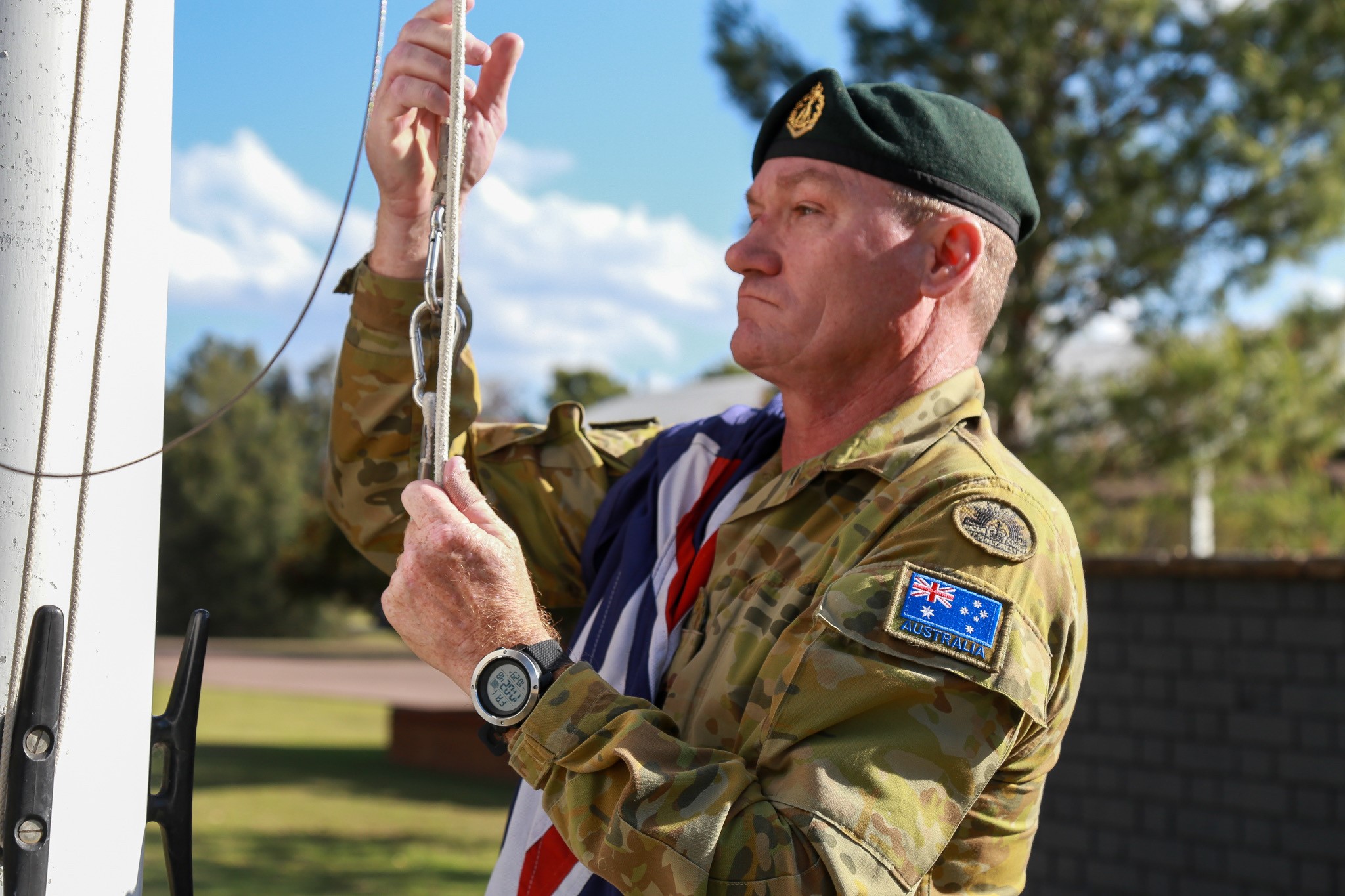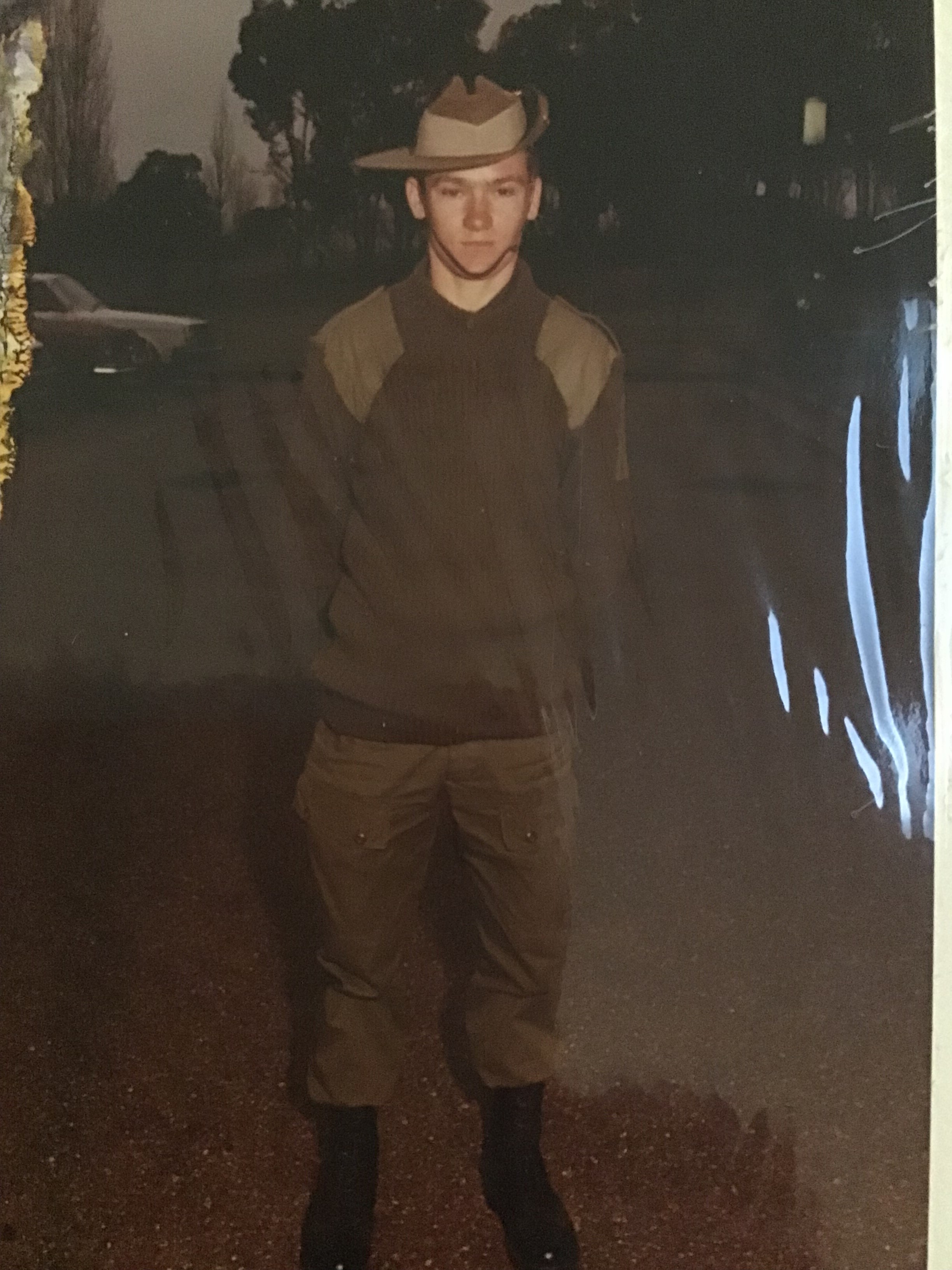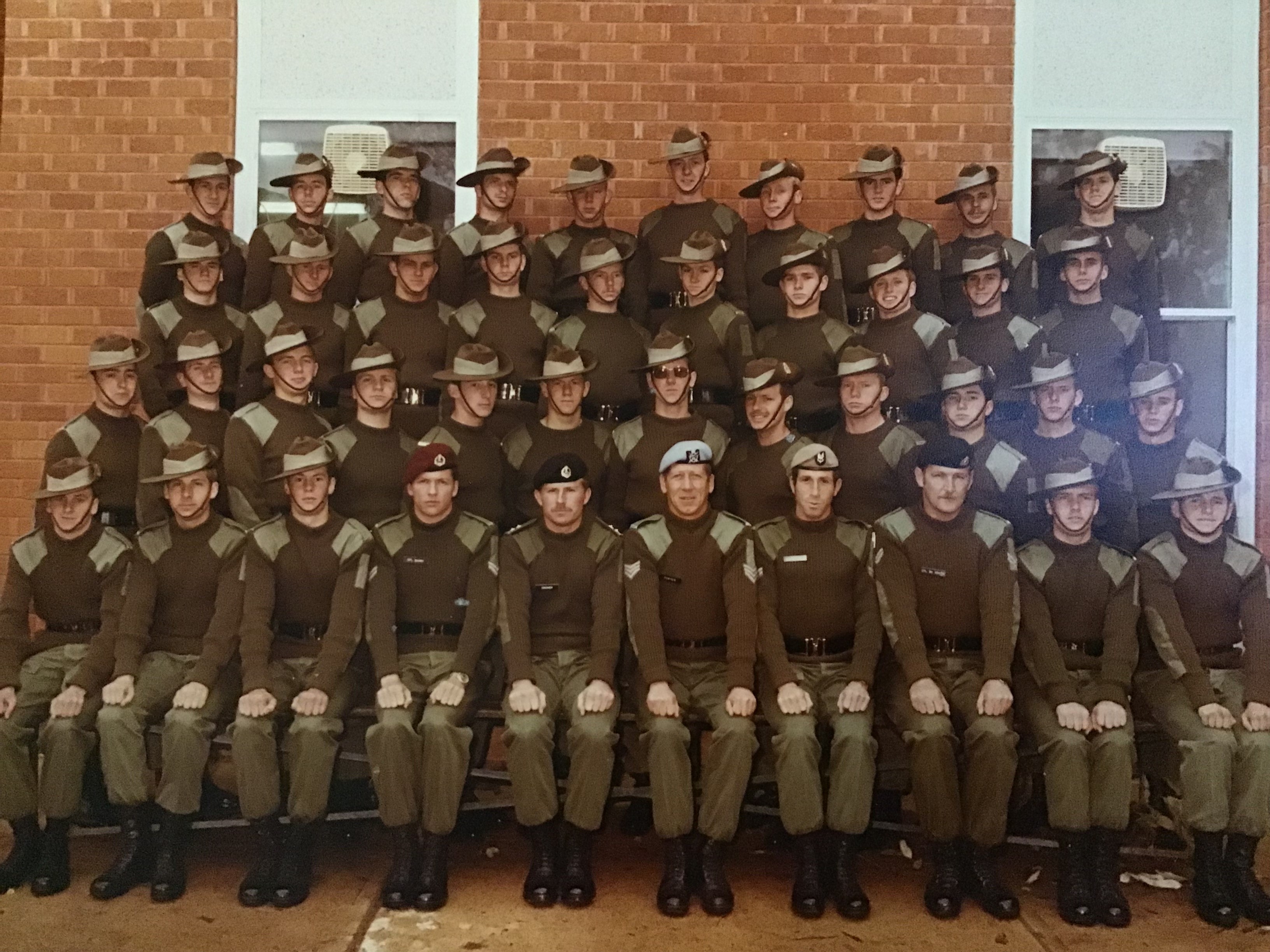
John Stonebridge – an Amazing Army Career for an ‘Average Soldier’
BY DI SNEDDON
There are times when I find it hard to start a story and this story of John Stonebridge, is definitely one of those times, but here goes.
John Stonebridge bursts into laughter one minute and at other times he is deadly serious as he recalls his life in the Australian Army and in the Infantry Corps.
His career spans over 40 years, starting and ending at Singleton School of Infantry. His professional career ending late last year with the presentation of the Federation Star for 40 years of continuous service in the Australian Defence Force, an honour bestowed upon him by Australian Army Forces Commander, Major General M. Pearce AM.
The honour is rare and one John accepted with dignity and pride with a slash of humility. It has been a time of reflection of a job well done, a job that has taken him across the globe many times, a job where his colleagues became family and a job he could not have done without the support of his wife, daughters, family, friends and colleagues.
John spent his youth in an orphanage from a very young age until the age of nearly 16 when he was fostered. He said that he was grateful for this start in life but knew that there was more then what was around him.
He spotted an Army Recruitment truck in Taree in early 1980 and thought this was his way forward but was under 18 and needed permission from his foster parents to join.
Being only 16 years and eight months of age when he first came across army recruitment, he signed the dotted line at 17 years and waited a further 2 months before heading off to Sydney to swear allegiance to the Queen.
After a night on the town, he headed to Wagga Wagga to undergo Basic Training at Kapooka under the directions and training of Vietnam veteran corporals and sergeants.

The rest of the new recruits in his platoon were the same age as him or just 18 or over and he remembers on his first night in bed, laying in his room shared by three others, hearing them moaning and saying what had they done and what a mistake to be here. In contrast, John, you see, was very much at home.
When John joined in 1981, the contracts were for three, six or nine year terms and John’s foster mother only signed his documents on the provision he signed for only three years, as she did not like this idea, 40 years later he was still in the army.
After completing basic training at Kapooka, John was posted to Singleton for basic Infantry Training and his platoon of 45 new recruits qualified as infantry soldiers. After 14 weeks of training, he remembers reading his section commander’s end of training report which he continues to have in hard copy. Apart from the numerous weapon qualifications, the one line sentence which still sticks out, says: “Private Stonebridge will make an average soldier.” His then section commander and John became long term mates and have been on various operations together, sharing many a beer throughout both their 40 plus year careers.
At the end of his Infantry Training, the whole platoon was posted to 10th Independent Rifle Company (10 IRC) at Land Warfare Centre, Canungra in Queensland where they underwent jungle training and were used as a training platoon for basic and advanced Jungle Training operations for Infantry Battalion members.
“We all loved the location and the hard realistic training, we had already bonded together as a platoon from basic infantry training and it was a great location, the training was hard but we played hard as well, out of the month we spent two weeks in the ‘jungle’ playing enemy and two weeks in the barracks training,” John said.

They had cash to spend and in those days learner drivers could ride whatever size motorbike they could afford and very early on, Canungra car park was home to more than 20 brand new motorbikes, John’s was a brand new 1981 GPZ and was his pride and joy. Morning Roll Calls indicates the consequences of these purchases, Instead of calling out by rank and name, the Vietnam Veteran Platoon Sergeant would first enquire who was dead or injured and who was in hospital.
This was also the time period that Great Britain became involved in the Falklands War. John and a mate had travelled by motorbike from Queensland back home in NSW for Christmas leave when they heard this news. His mate from Newcastle rang him up and both agreed that they had better get back to Canungra in case they were needed, so they jumped on their bikes and travelled nine hours non-stop back to their base.
Their surprised Platoon Commander had just lowered the Australian Flag at the Flag station when he spotted them both entering the barracks front gate. He asked them why they had returned and when told, laughed at them and told them to go back home, John then said that they could not return as they had both used the last of their cash to get back, so the good young officer kindly lent them $50 each for petrol money to get home.
Reflecting on his training, John said: “The staff up there were very good to us and we created long life friends, not just peers. I had the utmost respect for the Vietnam era of soldiers, they were a great generation of soldiers to guide us… often with tough love, [and] the rough and tough experience (he pauses briefly) we bonded strongly together.” With his tough training in Canungra drawing to the end, John said to himself, if this is what the army is like, I am in for life.
After the 12 months posting to Canungra, all members of the platoon were then posted to the Regular Infantry Battalions across Australia, John was posted to 3RAR in Holsworthy surrounding rumours it was to become a parachute unit.
He spent the next 14 years with 3RAR, promoted from private to sergeant and taking part in many military exercises as well as completing many day and night parachute jumps that John said brought out the best and the worst of those taking part.
As a parachute jump master doing dispatcher duties, he noticed who helped and those who didn’t help each other in the tight spaces within the aircraft.
“Space was tight, you couldn’t move, even squirming was difficult.”
John was happy to encourage reluctant paratroopers out the door or ramp as only a non-commissioned officer can. Sometimes they would do three to four jumps a day and two at night, with John making over 250 jumps in this time.
John came back to Singleton School of Infantry as a Sergeant Instructor in 1993/94 to Specialist Wing to instruct on Support Weapons such as Anti-Armour, Mortars and Heavy Machine Guns, where he stayed for three years before heading to Perth to 16th Battalion, The Royal Western Australia Regiment as the Regular Army Operations and Mortar Platoon Sergeant posted to the Army Reserve Battalion.
Two years later he was promoted to Warrant Officer Second Class (WO2) and while remaining in Perth he met his wife to be, Kendell, and together they would travel for his career spending time back again in Sydney in 2002-3 in 3 RAR as a Company Sergeant Major with time in East Timor, back to Perth for another three years as a Training Warrant Officer in Headquarters 13th Bde and then a posting of two years to the New Zealand Army as an instructor at the Officer Cadet School where John said it was a good career move for him but not so good for his wife because of the isolation and his time away from home training the officer cadets. It corresponded with the birth of his youngest daughter, Lillybeth.
At the end of 2006, John was promoted to Warrant Officer Class One and posted on promotion as the Regimental Sergeant Major (RSM), 12th/40th Battalion, The Royal Tasmania Regiment in Hobart, John has fond memories of Tasmania especially travelling north to south all the time to visit the spread out Army Depots across the island.
At the end of 2010, the posting orders for 2011 had the family heading to 1st Battalion, The Royal Australian Regiment in Townsville to be the battalion RSM. With such a long drive as a family road trip from Hobart to Townsville on the radar, John said the family made the mistake of booking into Hotel Versace on the Gold Coast for a couple of nights which certainly impressed Lillybeth, who has since compared every holiday accommodation the family have experienced.
As RSM at 1RAR, the battalion had just returned from combat operations in Afghanistan and was earmarked to be ready again by the end of 2011. With the required force preparation training involved and associated long periods away from family, it was a credit to all members of the unit to be ticked off once again, to be ready for operations at the close of 2011.
John considers this time with 1RAR, to be one of the highlights of his career, and looks back with great satisfaction to have had the opportunity to work with very good people, “loyal and dedicated officers and soldiers,” focussed and striving together in order to achieve the set task.
Two months into this posting with 1 RAR, Cyclone YASI hit and the troops training was interrupted for about two months as soldiers were helicoptered and trucked around to clean up north of Townsville.
“Basically, we dropped soldiers on either side of the affected towns on the coast line armed with chainsaws and they carved their way through the mess to the centre of the town, opening up roads for disaster relief,” he said indicating the diverse roles required of the Australian Soldier.
From 1 RAR, John was posted as RSM School of Infantry, Singleton in 2014 which came to an end in 2016, but included a 12 month tour of Afghanistan. John and family moved to Dundas in Sydney for John to take up the appointment as RSM 8th Brigade, the family remained in Sydney for 12 months and then decided it was time to set up a semi-permanent base back in Singleton. They bought a house in Singleton and John made the commute to Sydney, living on barracks at Dundas during the week for the remaining 12 months.
At the end of John’s tenure as RSM 8th Brigade, John was posted back to Townsville as RSM Combat Training Centre (CTC) in Townsville where soldiers and units were assessed for combat readiness for overseas deployments and operations. Again, he enjoyed his role but his family back in Singleton was beckoning him home and he was starting to think about the future, “retirement” dare we say it.
At the beginning of 2019 John informed his chain of command that he would see out the remainder of the year but had requested Long Service Leave to commence in early 2020 with discharge in 2021 to coincide with 40 years’ service, he came back to Singleton and home for the final 12 months of his career and said it really did feel like coming home. He said the time was right as he was both mentally and physically tired and had accomplished all that he intended plus so much more.

However, nothing is as clean cut as what it seems in the Australian Army and John was asked to come off Long Service Leave and be RSM School of Infantry in Feb 2020 at very short notice. John then returned back to his delayed Long Service Leave in April 2021 and discharged as a full time soldier on November 1, 2021.
Having now changed over to the Active Army Reserve in January and residing permanently in Singleton, allows him to continue his infantry connection. He is currently posted as the Second in Command at the Australian Army Infantry Museum, this allows him to mix with the instructors and soldiers at the School of Infantry and Museum and enjoy the “semi-retirement” and quintessential way of life of a small country town.
John’s life, given its rocky start, could well have ended in a variety of outcomes but his decision to join the Army, gave him the shot of success at a time in his life when he admits he most needed it. While amazing experiences throughout, it is the friendships he developed along the way that is the greatest gift this ‘average soldier’ has had from his dedicated 40 years’ service.
